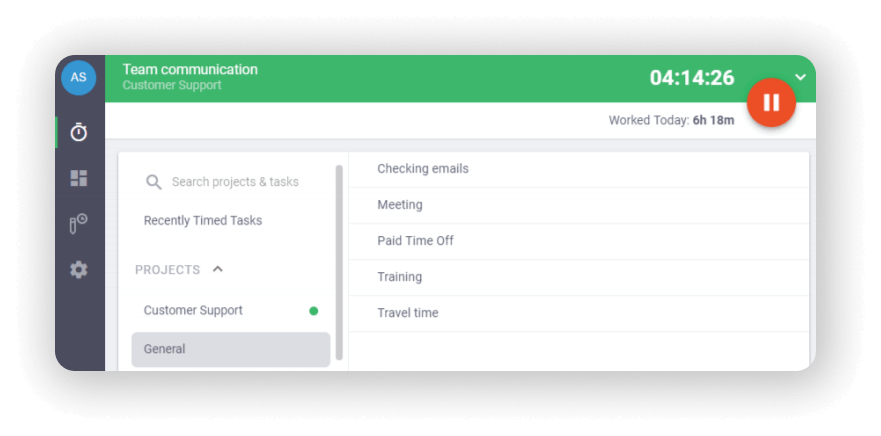Are you finding social media collaboration a challenge within your remote team? This article will guide you through the exact steps and tools you can use to make it easier.
Remote working is a necessity that a lot of worldwide companies had to adapt in order to survive. But something that once was a necessity actually turned into a preference for many employees.
In fact, studies show that 99% of employees would choose to work remotely, at least part-time, for the rest of their careers.
That’s a staggering number of people that companies cannot ignore. So the only viable option is to integrate remote working into their long-term business practices.
But when it comes to companies with an in-house marketing department, how can you make working remotely easier and more accessible? How can you stay in touch with your colleagues and make sure everybody’s doing their job? And how can you make sure that information reaches everybody in your marketing department?
The short answer is social media collaboration.
Establishing collaboration and a sense of community in your social media team is a must. You want your designers, copywriters, managers, and the rest of the team to be on the same page at all times. But it’s easier said than done when your team is working remotely, right?
Fortunately, there are tools that can help us manage and coordinate our employees or coworkers even from the comfort of our own homes. Let’s see what tools are most helpful when it comes to social media collaboration.
Social media collaboration tools
Without a doubt, there are a lot of tools available on the market when it comes to remote working. But of course, you don’t have time to try them all and see which ones work best for your team. This is when research comes into the picture.
And after hours of thorough research, we believe to have found the best-suited tools for remote working:
1. Slack

When it comes to communication, you need a fast and efficient tool. With Slack, you will be able to communicate not only with everybody in your team, but everybody in your company or in partnering companies.
Slack prides itself to be an easy and safe communication tool. But how does it work?
You can create channels to keep in touch with everybody in your team, or just with people that are involved in a certain project. If needed, you can share files and even connect with others via voice or video calls.
And if you use other tools, you can integrate them into Slack by using the software’s API. By doing this, you will have everything you need at the tips of your fingers.
The starting price for Slack is $6.67. This package is recommended for small to medium-sized businesses, but you can go for the Pro version as well, which is $12.50. In case your company is very large, then you can contact Slack’s sales team and discuss a business offer.
2. Trello
When it comes to organizing tasks, Trello is a tool that you need to have in your repertoire. With Trello, you can have boards for different teams and assign a list to each team member.
In this list they can have cards that contain their tasks. Using the card and list system, you and your team can prioritize and organize different projects. You can customize your cards by adding members, reminders, checklists, due dates, certain attachments, and much more.
Basically, your cards can store all the information you need to complete your tasks. And the best part about this tool is that it’s free. So you can keep your social media team organized and save up some money.
3. Zoom

Holding meetings is inevitable, especially when working with a remote team. Be it to share news, ask for questions and opinions, delegate new tasks, or just to catch up, you need face-to-face interaction. And Zoom works perfectly for that.
In fact, Zoom offers a plethora of options and plans, some of which include the meeting and chat option, the phone system, the video webinars, or the room and workplaces option.
Zoom gives solutions for different needs, and the prices are charged depending on the solution you need. But let’s concentrate on the meetings and chat option.
By purchasing this feature, you will be able to organize secure meetings with your colleagues. People will be able to join from any device and use built-in tools, such as the screen-sharing tool. They will also have access to features such as filters, reactions, and polls.
And of closure, the quality of the audio and video will be top-notch. You can try Zoom Meeting for free using their Basic plan, or you can choose one of their paid options, which comes at $149.90, $199.90, and $350 per year.
4. InVision
InVision is by far one of the best and most complex tools for social media collaborations.
You can create prototypes and work directly on them as a team, by leaving comments or suggestions. Not only that, but you can collaborate in real-time by using a digital whiteboard and encouraging your team to participate in the brainstorming process.
With the Freehand feature, your team will be able to provide feedback in realtime on anything visual. And with the Studio feature, your designers will be able to work together on the same designs due to the global syncing and real-time updates.
Not only that, but your design and coding teams will be able to cooperate and work together to bring your ideas to life. All in all, InVision is a tool that will bring everybody together to work harmoniously.
InVision has a free option, but you have the choice of purchasing a Pro option, which costs $7.95 per month, or you can contact the company for the Enterprise package.
5. Google Drive

Google Drive is one of the most useful tools that a company can have. You can store and share any kind of files with anybody from your team. And if you’re afraid of running out of storage space, you can rest assured about that, because Google Drive lets you have all the space you need.
You can even keep your team’s files organized by creating a shared space. And of course, you will have access to the other features that Drive comes with— Gmail, Google Meet, Calendar, Google Docs, etc.
You have four options for Google Drive: Business Starter, Business Standard, Business Plus, and Enterprise. The starting point is $6 for the Business Starter. The prices continue with $12 and $18 and for the Enterprise package you can contact their sales team to negotiate.
6. You Need a Wiki
If you have a lot of procedures that your employees need to respect or reference, then you might need a wiki.
A lot of questions might arise when working remotely and sometimes, supervisors are hard to reach. This is when having information regarding internal procedures and how-tos come in handy.
With YNAW, you will be able to have all the information in one place. Not only that, but you can structure your data into chapters and subchapters so your employees have easy access to the parts they need.
This service is free for one user, but if you want to make it available to your employees, you can purchase it at $10, $49, or $99 per month.
7. Time Doctor

Keeping track of time is very important when you are working remotely. You don’t want to take longer breaks than necessary and then stay overtime to catch up on work.
Basically, staying productive during work is of utmost importance, which makes TimeDoctor a necessary tool.
TimeDoctor will help you better plan your work and manage your projects by tracking how much time your team spent on certain tasks. The reports that TimeDoctor offers will help you track the productivity level of your team and assign tasks in a more efficient manner.
TimeDoctor will also show you if your employees spend time on unproductive websites during work and it will even notify them when they are on websites not related to work.
You can try TimeDoctor today for free and see if it matches your needs. If it does, you can start using it at only $7 a month.
Tips for social media collaboration

The truth is that even if you have all the social media collaboration tools, that doesn’t necessarily mean that your remote team will work well. Sure, these tools will help when it comes to collaboration.
But how can you encourage your team to use these tools? How can you make sure that everybody will communicate effectively? And how can you ensure that the productivity levels stay the same as in the office?
Even though tools can and will help you and your remote team considerably, your work ethics and how you handle certain situations matter most. And so, with that thought in mind, let’s see some tips that will help you and your team work successfully from home.
1. Create a safe virtual work environment
Many would say that creating a safe space at the office is much harder than in the online environment. But that is not entirely true.
The truth is it’s very easy to disconnect when you’re behind a screen. You don’t see the other person’s reaction to what you said, so you don’t know the full impact of your words. So what can seem common sense or fair feedback from your part, might be interpreted differently.
There are ways in which you can avoid this. When it involves your direct contacts, what you can do is try to be as considerate as possible, while also being honest. Try using the compliment sandwich method when you need to give feedback.
If you need to give a lot of negative feedback, then the best thing is to organize a meeting and have the talk face-to-face. That way you can ease them into the conversation and see if they become uncomfortable. And if you want to make sure that your meeting goes without a hitch, then you must definitely avoid some common mistakes.
When it comes to interactions with your whole team, you can monitor the chats. Make sure there are no unanswered questions and try to create a pleasant and easy-going atmosphere.
Also, a good idea is to have work-related groups, and then have a fun-orientated group. This is where your team can come and let off some steam. They can either talk about their day and share memes, news, or music.
2. Perform regular check-ups

Performing regular check-ups on your social media team is vital. Although you might use tools that will show you at what stage of the project each team member is, that isn’t enough.
Your coworkers might stay on track and keep everything updated, but that doesn’t mean they are doing well. They might be struggling to keep up with their workload, which is why personal check-ups are needed.
You can drop by every other day and ask each team member how they are doing, how is work going, and if they need any help. Assure your coworkers or employees that there’s nothing wrong with not handling their tasks or finishing on time.
And of course, if your employee opens up to you, try to come up with a solution. What you can do is give them more time to complete their part of the project or ask another coworker to help. Enforce the idea that you are a team and helping one another is only natural.
3. Make sure everybody is using the tools you proposed
There’s no use in getting the tools above if your team is not going to use them. What you can do in this situation is ask you, team members, what they think of certain tools before actually getting them.
Inform them of the tool in question and give them all the information they need. If the tool has a demo, make that accessible to them as well. After a few days, ask your team if they think the tool is going to be useful for them.
Another thing you could do is take the tool for a spin trial. Purchase it for a month and have your team try it. After they have used it for a longer period of time, they can tell you if it’s going to be useful for them or not.
If you’re already integrated certain tools into your work routine, check to see if your team is actually using them. If they aren’t, find out the reason and see how you can motivate them to use the softwares or apps.
4. Encourage open communication

Communication is the most important thing when it comes to social media collaborations.It doesn’t matter that you have talented people working for you if they don’t know how to cooperate.
Most of the tools mentioned encourage collaboration, but you have to do your part and enforce communication. You can start doing this by doing regular check-ins and asking for feedback.
And don’t just stick to work talk. Try asking your team about their day, how they are feeling, how is their family, etc. This way, your coworkers will see that you are open and easy to talk with and they will come to you whenever there is an issue.
You can try building trust using other techniques that are just as effective.
Conclusion
Working remotely might not be the easiest option, but it definitely is the preferred one. So the only thing that remains to be done is to make sure that everything runs smoothly. This means that your projects need to have great quality and meet their deadlines.
We’ve seen the tools that can be used to foster social media collaboration in remote teams, but in the end, it all depends on you and your team.
So the best thing you can do is improve work etiquette and make sure you adopt good practices when it comes to teamwork.
About the Author

Ovi Negrean is the CEO and Co-Founder of SocialBee, one of the most user-friendly social media management tools on the market. He and his team help startups, small businesses, freelancers, and entrepreneurs reach their marketing goals through keyword-informed and customer-driven articles, as well as innovative social media content.


